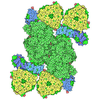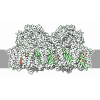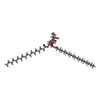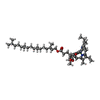+ Open data
Open data
- Basic information
Basic information
| Entry | Database: PDB / ID: 8wnw | |||||||||
|---|---|---|---|---|---|---|---|---|---|---|
| Title | the structure of PsaQ | |||||||||
 Components Components | PsaQ | |||||||||
 Keywords Keywords | PHOTOSYNTHESIS / chlorophyll / alloxanthin / growth phase | |||||||||
| Function / homology | CHLOROPHYLL A / 1,2-DISTEAROYL-MONOGALACTOSYL-DIGLYCERIDE Function and homology information Function and homology information | |||||||||
| Biological species |  Rhodomonas salina (eukaryote) Rhodomonas salina (eukaryote) | |||||||||
| Method | ELECTRON MICROSCOPY / single particle reconstruction / cryo EM / Resolution: 3.5 Å | |||||||||
 Authors Authors | Zhang, S.M. / Si, L. / Li, M. | |||||||||
| Funding support |  China, 2items China, 2items
| |||||||||
 Citation Citation |  Journal: Commun Biol / Year: 2024 Journal: Commun Biol / Year: 2024Title: Growth phase-dependent reorganization of cryptophyte photosystem I antennae. Authors: Shumeng Zhang / Long Si / Xiaodong Su / Xuelin Zhao / Xiaomin An / Mei Li /  Abstract: Photosynthetic cryptophytes are eukaryotic algae that utilize membrane-embedded chlorophyll a/c binding proteins (CACs) and lumen-localized phycobiliproteins (PBPs) as their light-harvesting antennae. ...Photosynthetic cryptophytes are eukaryotic algae that utilize membrane-embedded chlorophyll a/c binding proteins (CACs) and lumen-localized phycobiliproteins (PBPs) as their light-harvesting antennae. Cryptophytes go through logarithmic and stationary growth phases, and may adjust their light-harvesting capability according to their particular growth state. How cryptophytes change the type/arrangement of the photosynthetic antenna proteins to regulate their light-harvesting remains unknown. Here we solve four structures of cryptophyte photosystem I (PSI) bound with CACs that show the rearrangement of CACs at different growth phases. We identify a cryptophyte-unique protein, PsaQ, which harbors two chlorophyll molecules. PsaQ specifically binds to the lumenal region of PSI during logarithmic growth phase and may assist the association of PBPs with photosystems and energy transfer from PBPs to photosystems. | |||||||||
| History |
|
- Structure visualization
Structure visualization
| Structure viewer | Molecule:  Molmil Molmil Jmol/JSmol Jmol/JSmol |
|---|
- Downloads & links
Downloads & links
- Download
Download
| PDBx/mmCIF format |  8wnw.cif.gz 8wnw.cif.gz | 47.7 KB | Display |  PDBx/mmCIF format PDBx/mmCIF format |
|---|---|---|---|---|
| PDB format |  pdb8wnw.ent.gz pdb8wnw.ent.gz | 30 KB | Display |  PDB format PDB format |
| PDBx/mmJSON format |  8wnw.json.gz 8wnw.json.gz | Tree view |  PDBx/mmJSON format PDBx/mmJSON format | |
| Others |  Other downloads Other downloads |
-Validation report
| Summary document |  8wnw_validation.pdf.gz 8wnw_validation.pdf.gz | 1.1 MB | Display |  wwPDB validaton report wwPDB validaton report |
|---|---|---|---|---|
| Full document |  8wnw_full_validation.pdf.gz 8wnw_full_validation.pdf.gz | 1.1 MB | Display | |
| Data in XML |  8wnw_validation.xml.gz 8wnw_validation.xml.gz | 23 KB | Display | |
| Data in CIF |  8wnw_validation.cif.gz 8wnw_validation.cif.gz | 29.2 KB | Display | |
| Arichive directory |  https://data.pdbj.org/pub/pdb/validation_reports/wn/8wnw https://data.pdbj.org/pub/pdb/validation_reports/wn/8wnw ftp://data.pdbj.org/pub/pdb/validation_reports/wn/8wnw ftp://data.pdbj.org/pub/pdb/validation_reports/wn/8wnw | HTTPS FTP |
-Related structure data
| Related structure data |  37674MC  8wm6C  8wmjC  8wmvC  8wmwC M: map data used to model this data C: citing same article ( |
|---|---|
| Similar structure data | Similarity search - Function & homology  F&H Search F&H Search |
- Links
Links
- Assembly
Assembly
| Deposited unit | 
|
|---|---|
| 1 |
|
- Components
Components
| #1: Protein | Mass: 23834.393 Da / Num. of mol.: 1 / Source method: isolated from a natural source / Source: (natural)  Rhodomonas salina (eukaryote) Rhodomonas salina (eukaryote) | ||||
|---|---|---|---|---|---|
| #2: Chemical | ChemComp-LMG / | ||||
| #3: Chemical | | #4: Water | ChemComp-HOH / | Has ligand of interest | Y | |
-Experimental details
-Experiment
| Experiment | Method: ELECTRON MICROSCOPY |
|---|---|
| EM experiment | Aggregation state: PARTICLE / 3D reconstruction method: single particle reconstruction |
- Sample preparation
Sample preparation
| Component | Name: pigment binding protein / Type: COMPLEX / Entity ID: #1 / Source: NATURAL |
|---|---|
| Source (natural) | Organism:  Rhodomonas salina (eukaryote) Rhodomonas salina (eukaryote) |
| Buffer solution | pH: 7.5 |
| Specimen | Embedding applied: NO / Shadowing applied: NO / Staining applied: NO / Vitrification applied: YES |
| Vitrification | Cryogen name: ETHANE |
- Electron microscopy imaging
Electron microscopy imaging
| Experimental equipment |  Model: Titan Krios / Image courtesy: FEI Company |
|---|---|
| Microscopy | Model: FEI TITAN KRIOS |
| Electron gun | Electron source:  FIELD EMISSION GUN / Accelerating voltage: 300 kV / Illumination mode: FLOOD BEAM FIELD EMISSION GUN / Accelerating voltage: 300 kV / Illumination mode: FLOOD BEAM |
| Electron lens | Mode: BRIGHT FIELD / Nominal defocus max: 2300 nm / Nominal defocus min: 1200 nm |
| Image recording | Electron dose: 60 e/Å2 / Film or detector model: GATAN K2 QUANTUM (4k x 4k) |
- Processing
Processing
| CTF correction | Type: PHASE FLIPPING AND AMPLITUDE CORRECTION | ||||||||||||||||||||||||
|---|---|---|---|---|---|---|---|---|---|---|---|---|---|---|---|---|---|---|---|---|---|---|---|---|---|
| 3D reconstruction | Resolution: 3.5 Å / Resolution method: FSC 0.143 CUT-OFF / Num. of particles: 38675 / Symmetry type: POINT | ||||||||||||||||||||||||
| Refinement | Cross valid method: NONE Stereochemistry target values: GeoStd + Monomer Library + CDL v1.2 | ||||||||||||||||||||||||
| Displacement parameters | Biso mean: 75.86 Å2 | ||||||||||||||||||||||||
| Refine LS restraints |
|
 Movie
Movie Controller
Controller







 PDBj
PDBj









